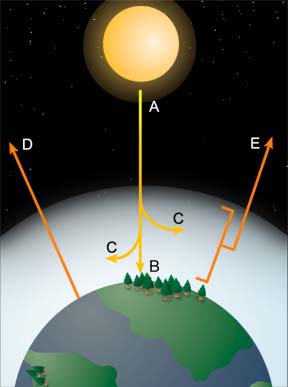
The major factor, therefore, that is involved in producing variations in the biosphere is the amount of radiation that the earth receives from the sun on different parts of the earth's surface. At the equator, the sun's rays are almost perpendicular during most of the year. Therefore, at the equator, one would expect to find higher temperatures but because the earth, tilted on its axis, certain areas of the earth's surface receive much more energy during certain times of the year than during other times of the year. Therefore, both the climate and the temperature are in some way controlled by the tilt of the earth, either toward or away from the sun. This causes the amount of energy reaching the different parts of the earth or its surface to vary hour by hour and season by season.
Using the figure located to the below, answer the following questions.
 A = 471 x 1062 calories / m / yr
light energy striking the earth from the sun
A = 471 x 1062 calories / m / yr
light energy striking the earth from the sun
E = 141 x 1062 calories / m / yr light energy reflected back from atmosphere
C = 94 x 1062 calories / m / yr light energy absorbed by CO2 and H2O in the atmosphere
D = 14 x 1062 calories / m / yr reflected back from surface of the earth
B = 6 x 1062 calories / m / yr converted into macromolecules by photosynthesis
What percent of the energy is absorbed by the atmosphere?
What percent of the solar energy is reflected back into space from the atmosphere?
What percent of the solar energy is used by living organisms?
What causes the seasons in the northern hemisphere of the earth?
- a. The movement of earth away from the sun in the winter and towards the sun during the summer.
- b. The tilt of the earth on its axis towards the sun in the summer and away from the sun in the winter.
- c. The earth’s elliptical orbit around the sun.
Created by the Multimedia Development Lab, Academic Technology Services.
Last modified November 21, 1997.